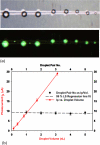Liquid dielectrophoresis and surface microfluidics
- PMID: 20697595
- PMCID: PMC2917863
- DOI: 10.1063/1.3411003
Liquid dielectrophoresis and surface microfluidics
Abstract
Liquid dielectrophoresis (L-DEP), when deployed at microscopic scales on top of hydrophobic surfaces, offers novel ways of rapid and automated manipulation of very small amounts of polar aqueous samples for microfluidic applications and development of laboratory-on-a-chip devices. In this article we highlight some of the more recent developments and applications of L-DEP in handling and processing of various types of aqueous samples and reagents of biological relevance including emulsions using such microchip based surface microfluidic (SMF) devices. We highlighted the utility of these devices for on-chip bioassays including nucleic acid analysis. Furthermore, the parallel sample processing capabilities of these SMF devices together with suitable on- or off-chip detection capabilities suggest numerous applications and utility in conducting automated multiplexed assays, a capability much sought after in the high throughput diagnostic and screening assays.
Figures













Similar articles
-
Leveraging liquid dielectrophoresis for microfluidic applications.Biomed Mater. 2008 Sep;3(3):034009. doi: 10.1088/1748-6041/3/3/034009. Epub 2008 Aug 15. Biomed Mater. 2008. PMID: 18708707 Review.
-
DEP actuation of emulsion jets and dispensing of sub-nanoliter emulsion droplets.Lab Chip. 2009 Oct 7;9(19):2836-44. doi: 10.1039/b905470g. Epub 2009 Jul 6. Lab Chip. 2009. PMID: 19967122
-
Integrated sample-to-detection chip for nucleic acid test assays.Biomed Microdevices. 2016 Jun;18(3):44. doi: 10.1007/s10544-016-0069-8. Biomed Microdevices. 2016. PMID: 27165104
-
Ultrasonic standing wave manipulation technology integrated into a dielectrophoretic chip.Lab Chip. 2006 Dec;6(12):1537-44. doi: 10.1039/b612064b. Epub 2006 Sep 11. Lab Chip. 2006. PMID: 17203158
-
Industrial lab-on-a-chip: design, applications and scale-up for drug discovery and delivery.Adv Drug Deliv Rev. 2013 Nov;65(11-12):1626-63. doi: 10.1016/j.addr.2013.07.017. Epub 2013 Jul 27. Adv Drug Deliv Rev. 2013. PMID: 23899864 Review.
Cited by
-
Preface to special topic: dielectrophoresis.Biomicrofluidics. 2010;4(2):22701. doi: 10.1063/1.3457488. Epub 2010 Jun 29. Biomicrofluidics. 2010. PMID: 22685499 Free PMC article.
-
Open-channel microfluidics via resonant wireless power transfer.Nat Commun. 2022 Apr 6;13(1):1869. doi: 10.1038/s41467-022-29405-2. Nat Commun. 2022. PMID: 35387995 Free PMC article.
-
Design and Fabrication of Microelectrodes for Dielectrophoresis and Electroosmosis in Microsystems for Bio-Applications.Micromachines (Basel). 2025 Feb 7;16(2):190. doi: 10.3390/mi16020190. Micromachines (Basel). 2025. PMID: 40047690 Free PMC article. Review.
-
Review: Electric field driven pumping in microfluidic device.Electrophoresis. 2018 Mar;39(5-6):702-731. doi: 10.1002/elps.201700375. Epub 2017 Dec 15. Electrophoresis. 2018. PMID: 29130508 Free PMC article. Review.
-
Wettability Manipulation by Interface-Localized Liquid Dielectrophoresis: Fundamentals and Applications.Micromachines (Basel). 2019 May 16;10(5):329. doi: 10.3390/mi10050329. Micromachines (Basel). 2019. PMID: 31100902 Free PMC article. Review.
References
-
- Chou H. -P., Unger M. A., and Quake S. R., Biomed. Microdevices ZZZZZZ 3, 323 (2001).10.1023/A:1012412916446 - DOI
LinkOut - more resources
Full Text Sources
Other Literature Sources
